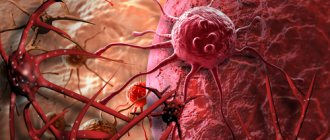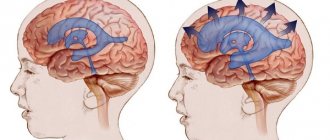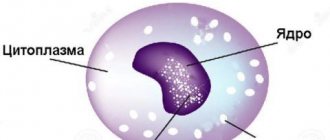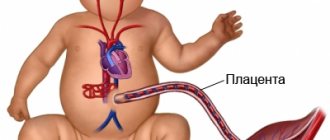What is vasculitis
During the disease, the upper and lower limbs of the child do not receive the required amount of blood.
The disease is severe. The main symptom is a rash. Small ulcers appear on the child's skin.
In the area of inflammation, damage to blood vessels occurs, then the pathology spreads to organs and joints.
It can be either a primary or secondary condition. Diagnosing the disease is difficult. At the moment, there are no laboratory tests to help identify pathology.
Symptomatic manifestation
Hemorrhagic vasculitis can be chronic, subacute, acute or fulminant in nature. The activity level can be high, moderate or minimal.
Acute vasculitis is accompanied by pain in the peritoneum and joints, fever, and general malaise. In this case, the temperature in the first stages of vasculitis can be high, after which it stabilizes.
Important information: How to treat cutaneous vasculitis and its symptoms
The fulminant type of vasculitis is accompanied by a rapid increase in negative symptoms. The patient develops a feverish state, hemorrhages and necrotic areas are observed on the skin. In this case, intestinal bleeding may occur.
A child with fulminant vasculitis may develop renal failure within a few days. With this form of pathology, medical care should be immediate and adequate. In its absence there is a risk of death.
The subacute form of the disease is characterized by gradual development. The problem is that most often subacute vasculitis in a child proceeds almost unnoticed.
Depending on the location of the pathology, there are the following forms of vasculitis:
- cutaneous-renal;
- renal;
- cutaneous-abdominal;
- abdominal;
- skin-articular;
- articular;
- cutaneous
Each type of disease has common symptoms such as nausea, vascular inflammation, skin rashes, and impaired functioning of the kidneys and digestive system.
Causes and essence of the disease
Doctors cannot say the exact cause of vasculitis in children, but they note that its development is most often influenced by an autoimmune disorder.
It can form against the background of chronic and infectious diseases, drug intolerance. Even overheating or hypothermia can affect the development of the disease.
The disease progresses when toxins accumulate in the subcutaneous layers. These substances negatively affect the functioning of blood vessels.
It can also develop after the baby is vaccinated. There were cases when the body reacted negatively to the administered drug.
In some cases, symptoms of the disease may occur independently, that is, not be associated with malfunctions of the organs.
Classification of vasculitis
Vasculitis is a general term that is used to classify pathologies characterized by damage to blood vessels and vascular walls of various organs and systems of the body. The disease appears in both males and females at any age. Vasculitis is especially dangerous in children, as it is very difficult to diagnose.
Modern medicine does not have a clear unified classification of vasculitis. They are divided according to a number of different characteristics: the degree of vascular damage, the size of damaged vessels, the location of symptoms, the size of the lesions and many others. In this regard, the typification of pathology is very complex and confusing; it is periodically revised and improved.
There are two fairly broad classes of pathology:
- systemic, when internal organs or entire systems suffer due to circulatory disorders caused by vascular damage;
- dermal, or skin, which is characterized by the appearance of rashes of different sizes on the skin. This class of pathologies is considered the least dangerous, as it causes virtually no complications.
If we consider vasculitis based on the reason for their occurrence, then we are classified into two groups:
- primary – an independent disease of an autoimmune nature;
- secondary – as a consequence of another pathology of various origins.
In principle, the classification of this disease is the same for both adults and children. But the development of vasculitis in a child is more dangerous. A fragile organism, which is in the stage of active development, is at risk of complications in the form of spread of the disease to all organs and systems of the body, which can lead to disability or even death.
The development of the disease is usually lightning fast and the course is acute. After recovery, there is a risk of relapse, especially in case of delay in seeking help or self-medication.
Common types
The most common types of vasculitis in children are:
- hemorrhagic;
- Kawasaki disease;
- urticarial vasculitis.
Cerebral vasculitis is extremely rarely diagnosed. It affects the arteries of the brain and spinal cord.
Causes include viral infections, Hodgkin's disease, and amphetamine use by pregnant women.
Cutaneous vasculitis is formed due to an acute allergic reaction. It affects the blood vessels of the skin.
After critical hypothermia, a child may develop cryoglobulinemia. During it, inflammation of small vessels occurs.
Inflammation of the artery walls is called arteritis. The inflammatory process in small arteries is arteriolitis, in the walls of capillaries - capillaritis, in the walls of veins - phlebitis.
When inflammation occurs in several types of vessel walls, then systemic vasculitis occurs.
Types of vasculitis in children
Depending on the causes of the disease and the stage of the disease, there are many types of vasculitis. Some affect only the skin without affecting the child’s organs. And there are species that can be very dangerous to the health of children.
In order to determine the method of treating the disease, it is very important to understand the form of manifestation of the disease. Today there are the following main types of vasculitis in children:
- Hemorrhagic.
- Systemic.
- Cerebral.
- Allergic.
All types of the disease have common characteristics: the same mechanism of development, a long period of occurrence, exacerbation processes alternate with improvement, all types of the disease are helped by medications that suppress the immune system.
The most common type of vasculitis is hemorrhagic vasculitis, which in children is a fairly rare infectious-allergic vascular disease, during which small capillaries and arteries are affected. Average statistical data indicate the presence of this disease in 23-25 people out of ten thousand. Hemorrhagic vasculitis in children occurs between the ages of 4 and 14 years. Boys are most affected by this disease. Typically, the disease is most common between 7 and 12 years of age. Children under three years of age practically do not suffer from this type of disease. The main causes of this type of disease include:
- Genetic disposition.
- Allergy to a certain drug.
- Reaction to vaccinations.
- Viral, bacterial, parasitic infections.
- Radiation background.
- Sudden change in body temperature.
- Insect bites.
- Injuries.
Children may develop heart murmurs. Boys may experience tenderness and swelling in the testicular area. The disease begins with a skin rash on the buttocks, lower and upper extremities. In most cases, the lower leg and knees are affected, and their deformation may occur. Swelling and pain may initially occur. In addition, one of the symptoms may be abdominal pain, which is accompanied by loose stools, paroxysmal contractions, vomiting, nausea, and fever. The autoimmune process is accompanied by the production of antibodies to one’s own body. Hemorrhages occur due to damage to the vascular walls. The temperature first rises to record levels, then returns to normal. In the fulminant form of the disease, the kidneys are completely affected. It is very important not to delay treatment, as the outcome can be unpredictable. If the disease develops gradually over a long period of time, hemorrhagic vasculitis can become chronic. Disorders of the central nervous system develop, and inflammation of the vascular membranes of the brain may appear.
Hemorrhagic vasculitis in children has various forms, resulting in damage to one or another organ or tissue:
- the skin form, in which only the skin is exposed to the rash, without affecting the child’s organs;
- articular form, which affects the joints of the arms and legs;
- the intestinal form is characterized by the appearance of a rash and damage to the blood vessels of the gastrointestinal tract;
- renal form of the disease, in which the child’s kidneys are damaged.
A serious symptom of hemorrhagic vasculitis is damage to the joints, which are accompanied by inflammation and pain. In children, as a rule, there is periarticular edema, and deformities may occur. Intestinal bleeding, necrosis, inflammation of the brain walls, peritonitis are some of the many serious serious consequences of vasculitis.
Systemic vasculitis in children is a type of complex of diseases that leads to damage to entire organs or tissues of the child’s body. In children, this type of disease is much less common than in adults, but it manifests itself in a more acute form. With a quick diagnosis and timely treatment, the child has a chance for a full recovery. The main symptoms of the disease include: the appearance of fever, loss of body weight, leukocytosis in the blood.
Cerebral vasculitis is a very rare, severe and dangerous disease that occurs in the blood vessels of the brain and can lead to tissue necrosis and hemorrhage. The causes of this type of disease have not yet been established. It is extremely difficult to make a diagnosis due to the fact that it is necessary to take a piece of the vessel for analysis, which can lead to bleeding.
Allergic vasculitis in children does not require special treatment and in most cases goes away on its own.
Classification
Vasculitis is a term used to describe a group of diseases affecting the condition of blood vessels. Their classification is based on the size of the vessels affected by inflammation.
Thus, with Kawasaki disease, inflammatory processes of small vessels and arteries of the heart are observed. The hemorrhagic type affects small vessels between the ages of 4 and 7 years.
Takayasu syndrome affects the aorta and the vessels coming from it. Often the branches of the aorta, through which blood flows to the head, are affected.
When inflammatory processes affect medium-sized vessels, the pathology is called vasculitis of the central nervous system. It affects the medium and small arteries, as well as the vessels of the kidneys and intestines.
Varieties of the subtype can also affect small vessels.
Types of vasculitis and causes of their occurrence
The exact causes of vasculitis in young children are unknown. Immunological abnormalities (autoimmune disorders) are currently considered the main cause of the development of inflammatory changes in the walls of blood vessels. The most common classification system is based on the size of the blood vessels affected by the inflammation.
The type of vasculitis depends on the size of the vessels
The most common types of vasculitis in children are:
- Schönlein-Henoch (better known as hemorrhagic type);
- Kawasaki disease;
- urticarial vasculitis.
Kawasaki disease is a type of inflammation of the medium and small vessels and arteries of the heart in children. But Henoch-Schönlein syndrome is an inflammation of small vessels, which is most often observed in children aged four to seven years.
Inflammation affecting large blood vessels is called Takayasu syndrome, giant cell arteritis. In Takayasu syndrome, inflammation usually affects the aorta and the main vessels leading from it. Giant cell arteritis typically affects the branches of the aorta that supply blood to the head.
Inflammations affecting medium-sized vessels are called polyarteritis nodosa or vasculitis of the central nervous system. The disease usually affects medium- and small-sized arteries, which include those of the kidneys and intestines. A variation of this subtype of the disease (microscopic polyangiitis) can also affect smaller vessels. Some studies show that there is a relationship between hepatitis B and inflammation of the medium vessels.
Kidney vessels are also susceptible to inflammation
Cerebral vasculitis is a very rare disease that is characterized by inflammation of the arteries of the brain and spinal cord. The causes of the rare disease may be associated with certain viral infections, Hodgkin's disease, syphilis and amphetamine use by a pregnant woman or teenager.
Vasculitis also affects small vessels. For example, Churg-Strauss arteritis is an inflammation of small vessels, which are mainly found in the lungs. Wegener's granulomatosis is an inflammation of small arterioles and venules (systemic vasculitis). Granulomatosis can affect many organs, especially the kidneys, lungs, and upper respiratory tract (cavities and sinuses). Some cells (antineutrophil cytoplasmic antibodies) may be associated with Wegener's disease and are commonly found in the blood of young patients.
With granulomatosis, special antibodies can be detected in the blood
Cutaneous, or leukocytoclastic, vasculitis occurs as a result of an acute allergic reaction and affects the superficial blood vessels of the epidermis. Cryoglobulinemia is an inflammation of small blood vessels. Cryoglobulins are small protein complexes that can settle on the walls of blood vessels at cold temperatures. Typically, such a disease occurs after critical hypothermia in a child.
Some causes of small vessel vasculitis may be related to rheumatologic disorders (connective tissue diseases), especially systemic lupus erythematosus, rheumatoid arthritis, Behçet's disease, or relapsing polychondritis. But vasculitis of medium and large vessels can be caused by certain viruses.
The most common viruses associated with vasculitis are:
- Hepatitis B,
- hepatitis C,
- AIDS virus,
- cytomegalovirus,
- Epstein-Barr virus,
- parvovirus B19.
Symptoms
Symptoms of vasculitis in children include skin hemorrhages. As the disease progresses, ulcers form on the skin. Pathology manifests itself:
- elevated temperature;
- headaches;
- night sweats;
- rapid weight loss;
- darkening of urine;
- coughing up blood;
- emotional depression;
- loss of strength.
When the development of the disease is affected by sunstroke, the child shudders and feels nauseated.
With vasculitis, increased fatigue and frequent fainting are also observed. In some cases, there is migraine and vomiting.
As the disease progresses, visual acuity decreases and loss of sensitivity in the limbs occurs. External symptoms include bloody spots and ulcers.
Symptoms of vasculitis in a child
There are dozens of vasculitis - each of them affects one or another type of vessel and is accompanied by specific symptoms. They appear when damaged:
- skin - spotty hemorrhages;
- nerves - partial or complete loss of sensitivity;
- joints - joint pain;
- visceral vessels – abdominal pain;
- kidney – glomerulonephritis;
- brain - strokes.
General symptoms:
- weakness and increased fatigue,
- temperature increase,
- loss of appetite,
- pallor.
The most common vasculitis:
- hemorrhagic,
- allergic,
- urticarial,
- Wegener's granulomatosis,
- Kawasaki disease.
Hemorrhagic vasculitis is manifested by a palpable hemorrhagic skin rash, pain in the ankle and knee joints, sometimes in smaller ones. Cramping abdominal pain lasting from 3 to 10 days is not uncommon, and its clinical manifestations are similar to appendicitis, ulcer perforation and intestinal obstruction. Sometimes they are accompanied by nausea and vomiting, blood in the vomit and stool, and kidney damage - homerulonephritis. The diameter of the rash is 1-3 mm. The rash is symmetrical and initially appears on the legs and feet. Erythema and areas of necrosis are possible. Source: E.V. Borisova Hemorrhagic vasculitis in children // Pediatrics, No. 6, 2004, pp. 51-56
Symptoms of allergic vasculitis:
- erythematous and hemorrhagic spots and nodules;
- hemorrhages under the toenails;
- itching and pain in the rash area;
- necrosis – necrosis and blackening of the skin in the area of the rash;
- pain in muscles and joints.
The disease affects the lower extremities, and in generalized forms it also affects the trunk and forearms. In Behcet's disease, the mucous membranes of the mouth and eyes are affected, ulcers and erosions form.
With urticarial vasuclititis, dense blisters appear. Fever and muscle weakness, joint pain and kidney failure may occur. Diarrhea, conjunctivitis, laryngeal edema, increased intracranial pressure and cardiac arrhythmias are common.
Wegener's granulomatosis is manifested by damage to the kidneys and lungs, laryngeal stenosis, and nodular rashes on the skin.
Kawasaki syndrome - damage to the blood vessels of the heart, respiratory tract and lymph nodes. It begins rapidly with an increase in temperature to 38-41 oC. Other symptoms:
- debilitating fever;
- a rash with plaques that resembles scarlet fever;
- damage to the eyes and respiratory system;
- thickening and redness of the skin on the palms and soles;
- enlarged cervical lymph nodes;
- redness of the tongue;
- peeling of the skin of the fingers;
- aneurysm and heart pain. Source: I.Ya. Lutfullin Kawasaki syndrome: clinical algorithms and the problem of underdiagnosis of the disease // Bulletin of modern clinical medicine, 2020, vol. 9, issue 2, 52-60
Diagnostics
In addition to the lack of suitable tests, diagnosing vasculitis in children is complicated by the fact that young patients cannot accurately express their concerns. In addition, the disease mimics symptoms of other disorders.
These include allergies, poisoning, infections, and autoimmune diseases. To make an accurate diagnosis, the doctor studies the medical card and examines the child.
If vasculitis is suspected, tests are prescribed. They help rule out other diseases. Most often prescribed:
- blood culture;
- echocardiogram;
- tests for hepatitis and HIV.
To determine the specific type of vasculitis, I order a biopsy.
Pediatric vasculitis
Let's look at the most common and described types of vasculitis that affect children:
- Kawasaki disease affects small and medium-sized vessels, cardiac arteries in children. According to medical statistics, it can develop after 7 years, extremely rarely - at an earlier age.
- Henoch-Schönlein syndrome (hemorrhagic), in which lesions of small vessels are observed. The skin capillaries and larger subcutaneous vessels become inflamed, which is characterized by rashes of various locations and types. Develops in children from 4 to 7-8 years old.
- Takayasu syndrome, or giant cell arteritis, affects large blood vessels (the aorta and those leading from it). As a rule, the blood supply to the head is disrupted.
- CNS vasculitis, or polyarteritis nodosa, causes inflammation of medium-sized vessels. The kidneys and intestines suffer.
- Cerebral vasculitis is an extremely rare pathology that affects the vessels of the brain and spinal cord. It may occur as a result of certain infectious diseases, or if the mother uses amphetamines during pregnancy. If it develops in adolescence, it makes sense to ask the teenager about the same amphetamines.
- Churg-Strauss arteritis is an inflammation of small vessels in the lungs.
- Wegener's granulomatosis is a systemic vasculitis and occurs rarely in childhood - 2-3 cases per 100,000.
- Cutaneous (leukocytoclastic, or allergic) occurs as a result of an allergic reaction and affects small vessels of the skin.
It is not known for certain why vasculitis occurs in a child. The nature of this disease is very diverse and may vary depending on individual factors. But still, medical scientists managed to establish some cause-and-effect relationship.
Causes of pathology
The causes of vasculitis in both children and adults should be considered based on a broad classification of pathology.
Primary vasculitis (developing as an independent disease) is an incomprehensible phenomenon and, from a medical point of view, inexplicable today. There is a version that such diseases develop due to autoimmune abnormalities occurring in the body. Alternatively, due to an intrauterine mutation or genetic predisposition.
Secondary vasculitis, as a complication after illnesses, can appear after the following diseases or physical conditions:
- heredity (the genetic factor is in first place in this list);
- infectious pathologies of various origins, occurring in acute or chronic form;
- idiosyncrasy (individual intolerance) to vaccines, unsuccessful vaccination;
- reaction to medications used in the treatment of the underlying pathology (especially antibiotics and other drugs that affect the internal microflora of the body);
- reaction to household chemicals, pesticides, food chemicals;
- food and household allergies;
- prolonged exposure to extreme temperatures (both high and low);
- chemical and thermal burns;
- various injuries regardless of location.
Vasculitis in children occurs as a response of the body to prolonged exposure to an irritating factor, which the fragile developing organism cannot cope with on its own.
In addition, the modern environmental situation has such an unpredictable effect on the child’s body that the atypical course of any pathology is no longer something unique or very rare.
General symptoms of vasculitis in children
Vasculitis in children has many uncharacteristic symptoms, which makes its diagnosis extremely difficult. After all, a small patient cannot accurately formulate the cause of anxiety, the nature of the discomfort or the localization of painful sensations.
However, the overall clinical picture depends on the root cause of the pathology, the location of the process, the degree of its severity and the rate of progression:
- The very first sign of the disease will be small red dots on the child’s body. They resemble a mark from an insect bite, a small hemorrhage that at first does not rise above the surface of the skin.
- Then more pronounced and bright hemorrhages appear, which can ulcerate over time. Such skin manifestations cause itching and pain.
- A significant increase in body temperature, severe headaches, and deterioration in general condition are observed periodically, for no apparent reason.
- Migraine headaches may occur, which begin suddenly and go away just as suddenly.
- Against the background of general fatigue, fainting conditions may be present, including loss of consciousness.
- Attacks of nausea with retching, sometimes with vomiting and dizziness (especially if the cause of vasculitis is overheating).
- The child may complain of poor vision and will constantly squint. In bright light, the eyes begin to water and redden.
- Fingers and toes may partially (in severe cases completely, which is observed with fulminant flow) lose sensitivity. Small children cannot stand on their feet.
- When listening to pulmonary breathing, there is a feeling of rigidity, sometimes with wheezing (if the pulmonary vessels are damaged).
Parents need to monitor the child’s condition very carefully and if any of the symptoms occur, be sure to seek help from specialists. The consequences of vasculitis can be quite serious and the sooner treatment is started, the more optimistic the prognosis will be.
Hemorrhagic vasculitis
The most common form of pathology in children is hemorrhagic vasculitis.
It can develop due to the following factors:
- “childhood” diseases – chickenpox, scarlet fever, rubella, measles;
- other infectious diseases caused by pathological microflora of various origins;
- long-term helminthic infestations;
- reactions to vaccination or unsuccessful vaccination (to a weakened child, poor-quality or inappropriate vaccine);
- poisoning of various origins;
- allergic reactions to food, household chemicals, seasonal allergies.
The prevalence of provoking factors makes it necessary to consider hemorrhagic vasculitis in more detail. Moreover, complications after this form of pathology can be very serious. And the course of the disease itself can be lightning fast, and acute symptoms appear within 6-8 hours after the first signs appear. First, a hemorrhagic rash appears on the skin, varying in shape and size.
The following symptoms may occur immediately or a little later:
- an unexplained increase in temperature to low-grade levels, which is observed for several days;
- fatigue, apathy, lethargy of the baby against the background of an apparently normal state;
- heavy sweating, especially at night;
- joint pain (mainly the ankle and knees), muscle pain;
- wandering intestinal colic that occurs regardless of the consumption of food and stool. Bloody diarrhea follows later;
- urine becomes dark, sometimes streaked with blood;
- A dry cough begins, which develops into a hacking cough with the release of bloody sputum.
The danger is that with the fulminant form, a child may develop diseases that are unusual for childhood - heart attack, stroke, heart attack.
Treatment
In most cases, treatment is achieved without surgery.
The little patient will need care and constant monitoring from doctors. Once the diagnosis is made, full body monitoring is carried out for several weeks. Based on the data received, the doctor will prescribe treatment. Next, the child will be observed by a rheumatologist, nephrologist, neurologist, cardiologist and gastroenterologist.
Treatment with medications will be prescribed depending on the severity of the disease and the extent of organ damage.
Goals of therapy
The goal of treatment is to prevent complications and reduce the manifestations of the disease. It is aimed at maintaining stable remission and correcting organ disorders.
Stages of therapy
Most often, children from 10 to 16 years old are affected by hemorrhagic vasculitis. Its treatment depends on the form and phase of the disease. Vasculitis in children with mild and moderate phases is easily treatable. At a more severe stage, kidney failure, stomach pain, and bleeding appear.
For any form of the disease, antiplatelet agents are prescribed. At a severe stage, drugs are combined. For the initial stage of vasculitis, treatment takes about 3 months, for the average stage - six months, for severe - 1.5 years.
Chronic hemorrhagic vasculitis is treated in courses of 4-5 months. To eliminate severe damage to the digestive organs, Heparin is injected into the abdominal tissue.
In the treatment of chronic diseases, antihistamines are used. A course of treatment may be prescribed for 5-10 days with Tavegil, Suprastin and Fenkarol.
In addition to medications, a special diet is prescribed.
Treatment in a hospital setting
Treatment is carried out only in a hospital. The main requirement is bed rest. If this rule is not followed, the number of rashes increases.
The dosage of medications is selected strictly individually. When joint damage occurs, doctors prescribe non-steroidal anti-inflammatory drugs. For kidney damage, corticosteroid drugs and fresh frozen plasma are used, and for allergies, antihistamines and enterosorbents are used.
For abdominal syndrome, a 0.25-0.5% solution of novocaine, antispasmodics and proteolytic enzyme inhibitors are administered intravenously.
Vitamins C, P, E are also used. If necessary, helminthic infestations are treated and, if possible, foci of chronic infection are cleared.
Treatment of vasculitis
Conservative therapy for vasculitis is aimed at suppressing pathological autoimmune reactions with the production of antibodies. It is carried out in stages:
- relief of symptoms and achievement of remission;
- maintaining remission for 0.5–2 years;
- treatment of relapses.
In addition, prevention or elimination of concomitant diseases and complications is carried out.
The treatment regimen is based on the drugs of choice:
- hormones – for giant cell arteritis of GCA, polymyalgia rheumatica and Takayasu’s disease;
- hormones and cytostatics - for systemic, hemorrhagic and cryoglobulinemic vasculitis, polyarteritis nodosa and a number of others;
- immunosuppressants with hormones - for hemorrhagic vasculitis, if combination therapy with cytostatics is not effective;
- monoclonal antibodies - for systemic vasculitis, if combination therapy is not effective;
- basic antirheumatic drugs – in case of contraindications to the drugs of choice;
- immunoglobulins - for severe complications.
Diet therapy is also indicated . For functional kidney damage, plasmapheresis or hemosorption - hardware blood purification - are prescribed. In addition, according to indications, antiviral and symptomatic agents, antibiotics, drugs to maintain cardiac activity and prevent blood clotting are prescribed.
Conservative treatment of vasculitis is complex and long-term. In some forms, against the background of overgrowth, spasms and thrombosis of large vessels, surgical treatment is indicated. Without timely and correct treatment of vasculitis in children, the prognosis is unfavorable. The nature of the consequences depends on the type of disease.
Sources:
- https://academic.oup.com/ndt/article/30/suppl_1/i94/2324852 Despina Eleftheriou, Ezgi Deniz Batu, Seza Ozen, Paul A. Brogan. Vasculitis in children // Nephrology Dialysis Transplantation, Volume 30, Issue suppl_1, April 1, 2020, Pages i94–i103.
- E.V. Borisova. Hemorrhagic vasculitis in children // Pediatrics, No. 6, 2004, pp. 51-56.
- AND I. Lutfullin. Kawasaki syndrome: clinical algorithms and the problem of underdiagnosis of the disease // Bulletin of modern clinical medicine, 2020, vol. 9, issue 2, 52-60/
The information in this article is provided for reference purposes and does not replace advice from a qualified professional. Don't self-medicate! At the first signs of illness, you should consult a doctor.
Dietary recommendations
A prerequisite for the treatment of vasculitis is diet. In case of severe abdominal pain, table number 1 is prescribed, after which the child is transferred to table number 5. If the child is sick with the nephrotic variant, table number 7 is suitable for him. This is a salt-free diet with protein restriction.
After an illness, some foods will need to be excluded from the child’s diet. All food must be boiled, baked or stewed. It should be liquid or in the form of a paste. At the same time, you should reduce your salt intake.
During remission, you must adhere to a hypoallergenic diet for a year. With the permission of the hematologist, previously excluded products can be gradually introduced. Each product should be introduced a week after the previous one.
During the diet you should not consume:
- citrus;
- persimmon;
- currants;
- strawberries;
- strawberries;
- apricots;
- peaches;
- grenades;
- mango;
- red apples and grapes.
Baked green apples, bananas, and pears are allowed for consumption.
Prohibited vegetables:
- red pepper;
- beet;
- carrot;
- tomatoes;
- cucumbers
You can eat potatoes, zucchini, cabbage and green peppers. Cabbage should be boiled, stewed or steamed.
Eggs and their products, dairy products with additives, and glazed cheese curds are prohibited.
Meat allowed is rabbit, turkey, beef, and lamb. Do not eat fish or seafood.
Drinks you can drink are not strong tea or compotes.
Prevention
An important point in the prevention of vasculitis in children will be timely treatment of foci of inflammation. In this case, the child should not be given medications without a prescription from a specialist.
Good preventive measures would be hardening, walking in the fresh air, and eating a diet rich in vegetables and fruits.
Children who have had vasculitis should avoid hypothermia and should not come into contact with sick people and allergens.










